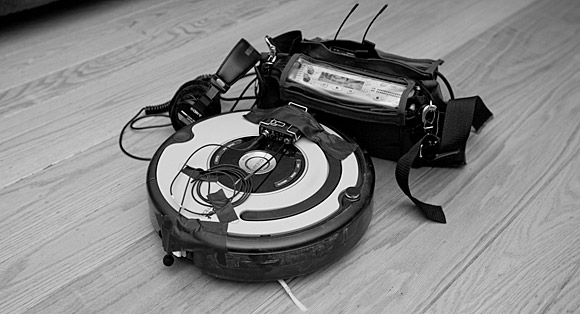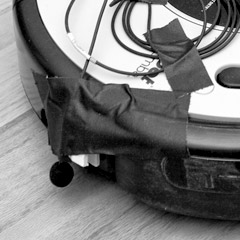Stupid Lav Tricks: A Robotic Primer
Posted: May 20th, 2010 | Author: Nathan | Filed under: found sound objects, gear
To paraphrase Ned Flanders, "That set my beatbox all the way up to Roomba!"
Lavalier microphones (“lavs”) are used with wireless transmitters and receivers all the time in the world of film and video production because, well, actors move. Sometimes it’s the best way to mic someone if you can’t keep up with their movement or a boom can’t get close enough, as with a wide shot. They’re not usually the first choice for miking talent, but they’re a common one and a good tool for certain conditions.
Wireless lavs are also handy in sound design for the same reason: Some things move. When they move, you need to pan your mic with it, or accept off-axis sound falloff, or be trying to get a Doppler effect. If you want your mic point-of-view to stay on something moving, and a cable’s going to get in the way, then a wireless mic system is just the ticket.
But, as with everything, there are some caveats.
First, lavs are really small, and that often means some compromises in their design. Some have limited dynamic range, others have pretty high self-noise. There are a lot of lavs to choose from on the market. DPA and Sanken produce lavs that rival expensive wired small-condenser microphones, and they command the pricetag to prove it. Countryman is a solid brand whose lavs represent killer values, and are famous for their moisture resistance.
Second, the fidelity of wireless audio is fraught with pitfalls. All units are susceptible to RF interference, and it can sometimes be hard to find a clean channel that’s not being broadcast on. Metal objects, interference, and intermodulation can all slay your range. Older or super-cheap units are VHF, which should be avoided in favor of current UHF or fully-digital units. Unfortunately, you get what you pay for in wireless systems, whose cost stretches over an order of magnitude, from $300 to $3000, typically for one channel of audio.
Finally, lavs need to be wired appropriately. This is usually XLR if you want wired, or for one kind of wireless transmitter. Your lavs can only be wired for one type of connection, period. A notable exception is DPA, which uses their own proprietary connector and sells a boatload of adapters. As long as the pin wiring is compatible, you’re good to go. (In a way, this makes DPA’s a great value if you want to run both wired and wireless.)
But the creative possibilities tend to be worth the investment. Modern lavs are tiny; they can be put anywhere, and can be hard to spot. This is why many recordists/phonographers use them for binaural recording. They weigh almost nothing, making them easy to rig. Many recordists use them to record vehicles for that reason (search for “lav engine” if you’re a member of the Sound Design Yahoo! Group.
That’s a lot of words to justify strapping a wireless lav to my robotic vacuum cleaner.

Ready to do donuts in my living room.
To make a long story unbearable, we got a new Roomba to replace an ailing one. The wheels make this neat, high-torque grinding sound when they rotate, and the engine sounds efficient and modern. I wanted to record it moving, especially manually moving it without the engine engaged, but I’m not a great boom op: I couldn’t move the Roomba and keep a mic the same distance 100% of the time.
So, I took a Countryman B3, plugged into a Lectrosonics transmitter, hooked up the receiver to my recorder, and let ‘er rip. (Hint: Be sure to isolate the mic from mechanical vibrations. Pick-n-pluck foam from Pelican cases is great, but so is the self-adhesive Dr. Scholl’s thick moleskin foam, the thicker version of what production recordists use to isolate lavs from apparel rubbing.)
You’ll notice in the photo above that there is a foam windscreen on the lav, and it’s hanging juuuust over the side edge of the Roomba; that’s where the wheel is. I neglected to remember that the Roomba just fits under our coffee table, so the transmitter got ripped off, but Lectrosonics units are built like tanks, and the Countryman lav cable is reinforced with kevlar, so no harm done!
Today’s sound is a collection of motor and wheel sounds that has me desperately wanting to spend a weekend redubbing parts of Wall•E for practice.
[soundcloud url=”http://soundcloud.com/noisejockey/roomba-wheels” params=”show_comments=true&auto_play=false&color=dd0000″ width=”100%” height=”81″ ]
[Countryman EMW B3 microphone via Lectrosonics UCR401 into Sound Devices 702 recorder]
funny, I´m doing the exact same thing right now =) gotta finish 4 minutes of wall-e for university and I spend the last days just to record any servo or mechanical noise that I can get.
Looking forward to see how your redubbings gonna be
Dude!!!
Great article. Love everything on your blog!
Very inspiring stuff. Keep it unreal!
Wicked!
great stuff. we have the some robot in our architectural office. would have enjoyed some recording, so the sounds at the end left some blank synapses inside. looking forward to hear some roomba rhythms…